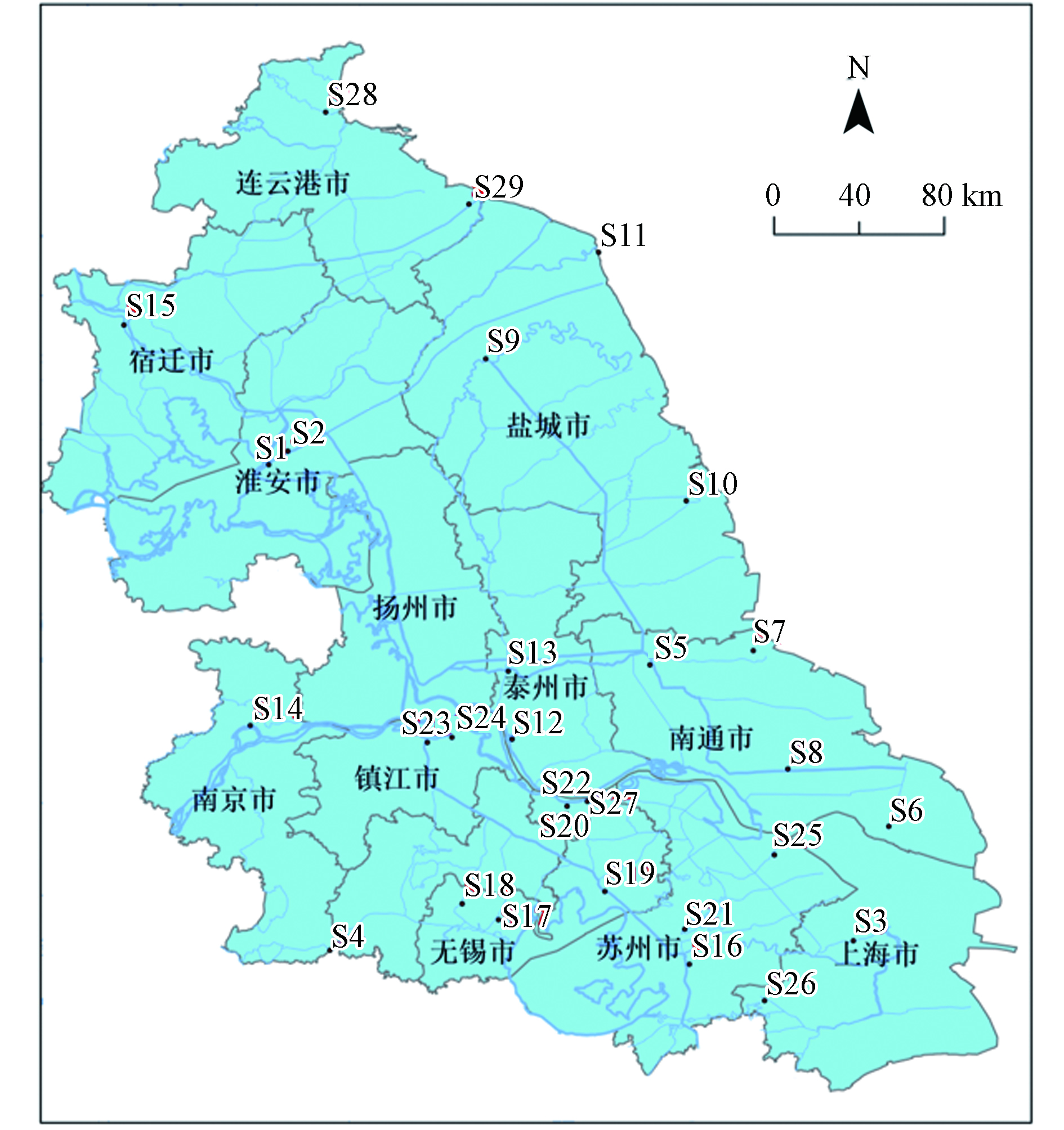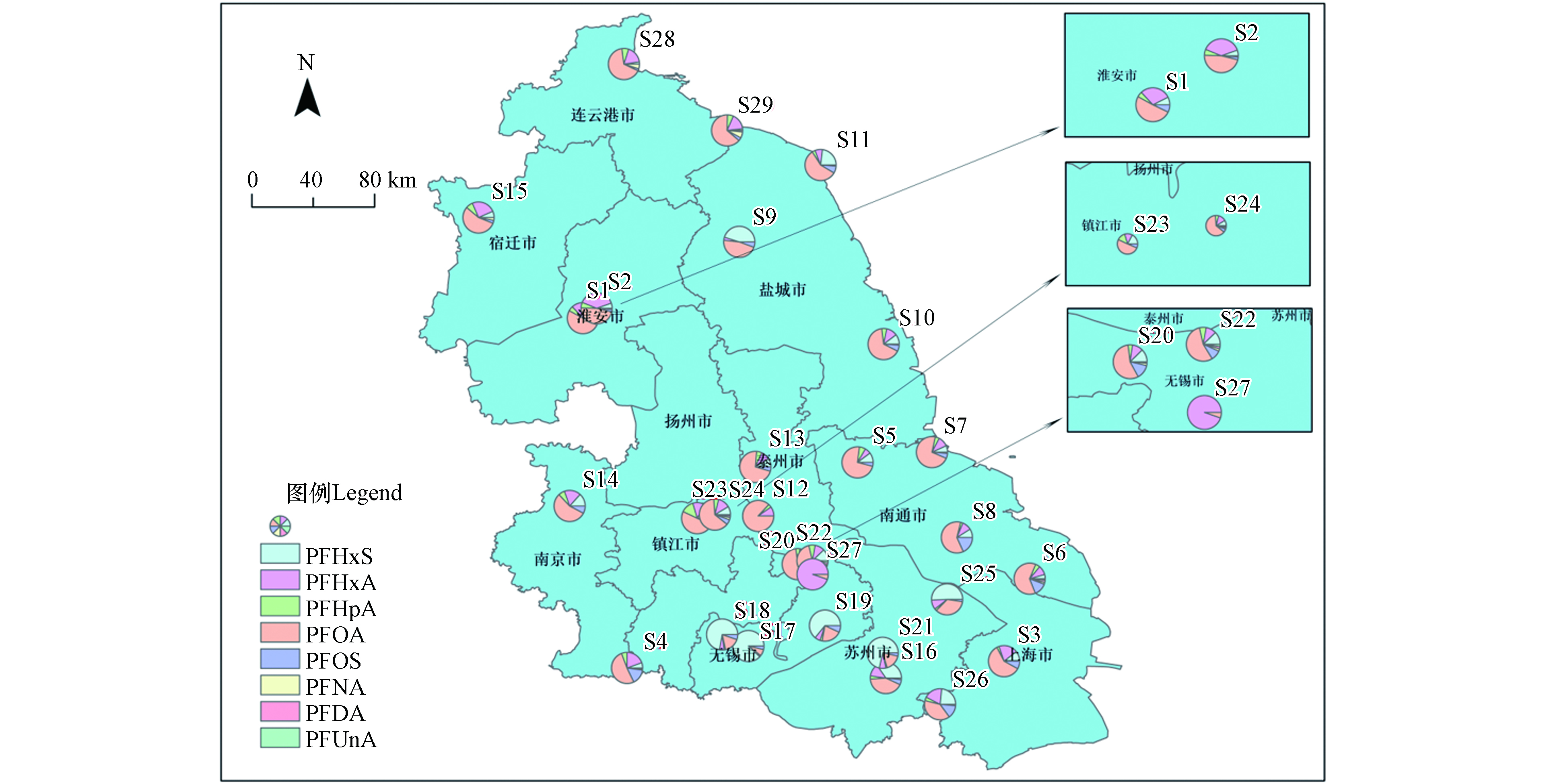-
PFASs是分子中与碳原子连接的氢原子全部被氟原子取代的一类持久性有机污染物,被广泛应用于织物、地毯、纸张、泡沫灭火剂、不粘锅、包装材料等生产制造领域,被大量地排放到环境中[1]. 同时由于其难降解,可远距离传输,并通过食物链在动物和人体中累积等特点,造成该类化合物在全球范围内广泛存在[2-3]. 研究表明,该类物质具有致畸、致癌、神经毒性和内分泌干扰等特性,其对人体健康存在潜在危害[4-5]. 此外,由于大部分PFASs具有较低的饱和蒸气压、较高的水溶性和很强的表面活性,使其在各种表层水体中累积,因此水环境是PFASs重要的汇和污染传输途径,了解PFASs在水环境中的分布特征极为重要[6-7].
随着发达国家逐步加强对PFASs的管控[8],氟化工产业逐渐由欧美等发达国家向发展中国家转移[9],我国氟化工产业主要集中在中部和东部地区,其中长三角地区是主要生产地[10-11],而氟化工产业的大规模发展会带来潜在的污染风险. 因此长三角地区的PFASs污染一直是学术界研究热点,但大部分长三角地区PFASs研究都集中在上海地区或少数城市,且部分研究主要集中在全氟辛烷磺酸(PFOS)和PFOA的研究,对长三角地区PFASs的整体污染研究不全面. 如Sun等[12]对上海水体中的PFASs的污染水平研究和Chen等[13]对常熟、淮安、盐城等城市的PFASs污染特征研究等.
本研究利用快速液相色谱-三重四极杆串联质谱联用检测技术,以长三角地区11个城市作为研究区域,选取了29个采样点,对该地区11种PFASs在水环境中的污染水平、污染特征、污染来源开展研究,并对该地区PFASs生态环境潜在风险进行评估,以期为该类化合物的全面、深入研究以及该区域水环境综合管理提供科学依据.
-
于2019年6月在长三角地区采集了29份河水,采样点(参照省级控制断面)位于长三角地区主要河流及支流,河流宽约20—50 cm,涉及11个城市覆盖长三角核心区域,具体点位见图1.
采样方法参考国家标准GB/T 26411—2010和HJ 805—2016,使用预清洁的聚丙烯塑料瓶采集2 L表层水(0—30 cm),避光冷藏送回实验室并在-4 ℃的冰箱中保存,在7 d内完成水样的前处理.
-
仪器:快速液相色谱-三重四极杆串联质谱仪(Agilent 1260/ABSIEX 4000Q)、24位固相萃取装置(visiprep-24TMPL)、氮吹仪(ETEL4 MG-2200)和涡旋仪(SI Vortex-2)等.
试剂:甲醇(色谱纯、Honeywell)、乙腈(色谱纯、Honeywell)、醋酸铵(色谱纯、广州化学试剂厂)和氨水(色谱纯、广州化学试剂厂)等.
标准品:全氟己烷磺酸盐(PFHxS)、全氟己酸(PFHxA)、全氟庚酸(PFHpA)、全氟辛酸(PFOA)、全氟辛烷磺酸盐(PFOS)、全氟壬酸(PFNA)、全氟癸酸(PFDA)、全氟十一酸(PFUnA)、全氟十二酸(PFDoA)、全氟十三酸(PFTrDA)和全氟十四酸(PFTeDA)、13C4-全氟辛酸(MPFOA)、13C4-全氟辛烷磺酸(MPFOS)和13C2-全氟正癸酸(MPFDA)(Wellington,纯度≥98%).
其它材料:WAX固相萃取柱(Agela,6 mL/500 mg)、针头过滤器(疏水性聚丙烯材质,0.22 μm)、1.5 mL旋盖平底瓶等.
-
量取经0.22 μm滤膜过滤后的水样1.0 L,加入4.0 ng内标物质(MPFOA、MPFOS和MPFDA),水样以每秒1—2 滴过WAX固相萃取柱萃取,WAX小柱预先用4.0 mL含0.5%氨的甲醇溶液、4.0 mL甲醇和4.0 mL超纯水活化,上样完成后的小柱抽真空干燥,干燥后依次用4.0 mL 0.5%氨的甲醇溶液、4.0 mL甲醇洗脱,洗脱液收集于10 mL试管中,氮吹至1 mL,用0.22 μm滤膜过滤后转移至1.5 mL进样瓶中,待上机检测.
-
液相色谱条件:流动相为5 mmol·L−1醋酸铵水溶液和乙腈,进样体积为10 μL,柱温为40 ℃. 质谱测定条件:离子源为电喷雾离子源,负离子模式(ESI-),雾化器为N2,干燥器气为N2,喷雾电压为4500 V,质谱扫描方式为多反应离子监测(MRM),入口电压EP为10.00 V,碰撞室出口电压CXP=-15.00 V. 各化合物优化的保留时间,MRM离子对,碎裂电压,碰撞能量见表1.
-
实验室空白 为控制样品前处理过程可能带来的外源性污染,实验过程避免使用聚四氟乙烯材质的器皿. 实验过程采用10%实验室空白,仅PFOA单体有检出,质量浓度为0.04—0.06 ng·L−1,所有实验结果均为扣除空白后的数据.
实验室平行 实验过程采用10%实验室平行,平行样的相对标准偏差为2.4%—13.1%. 基质加标:实验过程采用10%基质加标,加标回收率范围为75.4%—108.6%.
检出限 11种PFASs的检出限为0.015—0.47 ng·L−1. 方法满足检测要求,数据真实可信.
-
在数据分析过程中采用ArcGIS进行采样点位图绘制;采用Origin9.1进行相关数据图件绘制;采用Spass20.1进行主成分分析.
-
风险熵值(RQ)定义为测量的环境浓度(MEC)与预测的无影响浓度(PNEC)的比值,见式(1).
式中,RQ为风险熵,无量纲;MEC为实测环境质量浓度,ng·L−1;PCNC为预测无效浓度,ng·L−1. 当RQ≥1.0时,认为存在高风险,当0.1≤RQ<1.0时,认为存在中风险,RQ<0.1时认为存在低风险[14].
健康风险值(HR)定义为每日平均摄入量(ADI)与参考剂量(RfD)的比值,见式(2)和(3). 式中,ρ为PFASs的质量浓度,ng·L−1;V为日均饮水摄入量,L·d−1;m为人体质量kg;ADI为每日平均摄入质量分数,ng·kg−1;RfD为日摄入质量分数的参考值,ng·kg−1·d−1. 当风险值HR≥1.0时,认为存在高风险;当风险值为0.1≤HR<1.0,认为存在中风险;当HR<0.1时,认为无风险[14].
-
对长三角地区水体中的11种PFASs进行检测分析,其中PFDoA、PFTrDA和PFTeDA未检出,其它PFASs的检出浓度见表2. PFDA和PFUnA的检出率分别为89.7%和48.3%,其它PFASs单体的检出率均为100%,说明PFASs在长三角地区广泛存在. 各采样点PFHxS、PFHxA、PFHpA、PFOA、PFOS、PFNA、PFDA和PFUnA的浓度分别为0.51—260 ng·L−1、0.92—688 ng·L−1、0.59—19.60 ng·L−1、4.49—517 ng·L−1、0.38—20.1 ng·L−1、0.04—3.50 ng·L−1、ND—1.73 ng·L−1和ND—0.64 ng·L−1,各PFASs单体之间浓度差异较大.
各采样点位Σ8PFASs浓度见表2,Σ8PFASs的浓度为8.64—736.74 ng·L−1,浓度最高的3个点位分别为S27(无锡市)、S12(泰州市)和S25(苏州市),浓度分别为736.74 ng·L−1、598.02 ng·L−1和381.38 ng·L−1,此3个点位Σ8PFASs浓度显著高于其它点位,调查发现此3个采样点周边均存在大型氟化工企业,较高的Σ8PFASs浓度可能是受到周边氟化工企业的影响.
各采样点位Σ8PFASs组成特征见图2,除无锡市的4个点位和苏州市的2个点位主要污染物为PFHxA、PFHxS以外,其它点位的主要污染物均为PFOA,占研究区域Σ8PFASs的58.40%±11.06%,说明长三角地区PFASs污染主要污染物为PFOA,这与Sun [12]等的研究结果一致,其中氟化工企业是PFOA的主要的潜在污染源[15],而长三角地区存在的大量的氟化工企业对PFOA高浓度污染具有重要贡献.
无锡市和苏州市部分采样点位主要污染物为PFHxA和PFHxS,说明采样点位附近可能存在PFHxA和PFHxS的污染源,近些年类似PFHxA和PFHxS的短链PFASs由于其较小的生物毒性和生物积累效应,被大量生产用于代替中长链PFASs,导致类似PFHxA和PFHxS的短链PFASs的污染浓度及所占的比例逐年升高[4].
与国内外其它地区PFASs污染的比较见表3,本研究区域PFOA污染处在较高的污染水平,而PFOS的污染水平较低. PFOA的高浓度污染可能主要与研究区域存在大量工业源有关,而PFOS污染浓度较低可能是由于近几年我国对PFOS实行了严格管控政策,使其生产、使用和排放量大大减少.
-
PFASs的组成可以在一定程度上反映污染源的信息,其中PFOS/PFOA、PFOA/PFNA和PFHpA/PFOA常被用于确定PFASs的潜在污染源,比值见图3. 当PFOS/PFOA>1认为该地区存在PFASs点源污染[27],研究区域PFOS/PFOA为0.03—0.51,表明研究区域存在面源污染. 当PFOA/PFNA<7时认为该地区PFASs污染主要来源于间接来源,7≤PFOA/PFNA≤15时认为该地区PFASs污染主要来源于工业直接排放,PFOA/PFNA≥15时认为PFASs污染主要来源于前驱体降解[28],其中S1—S27的PFOA/PFNA比值为18.30—670.55,表明S1—S27的PFASs污染主要来自前驱体降解;S28—S29的PFOA/PFNA比值为10.22—13.94,表明S28-S29的PFASs污染主要来源于工业排放. 当PFHpA/PFOA>1时,说明该地区主要受到大气沉降的影响[29],研究区域PFHpA/PFOA的比值为0.038—0.265,所有点位均远远小于1,表明研究区域PFASs分布受大气沉降影响较小.
利用主成分分析法(PCA)进一步量化长三角地区PFASs污染的潜在来源及其贡献,本研究对29个点位检出PFASs含量数据进行PCA分析,结果如图4所示. 结果表明3个主成分可解释了长三角地区水环境中83.31%的PFASs污染来源,说明长三角地区PFASs主要来源于3种不同类型的污染来源. 其中PC1可解释长三角地区水环境中41.19%的PFASs来源,该成分中PFNA、PFUnA和PFOS具有较高的载荷;PC2可解释长三角地区25.15%的PFASs来源,该成分中PFOA和PFHpA具有较高的载荷;PC3可解释长三角地区14.96%的PFASs来源,其中PFHxA具有较高的载荷. PFASs的相关性分析结果见表4,PFDA、PFNA、PFUnA、PFOS之间和PFOA、PFHpA之间存在较好的相关性,相关系数分别为(R2=0.50—0.88,P≤0.01)和(R2=0.96,P≤0.01),也正说明了PFDA、PFNA、PFUnA、PFOS之间和PFOA、PFHpA之间可能具有一致的污染来源,而PFHxS和PFHxA与其它PFASs单体之间不存在相关性,说明PFHxS和PFHxA可能具有独立的污染来源. 根据PFASs不同来源的典型标志物可将解析因子与实际排放源结合起来,PFDA和PFNA是氟调醇(PTOH)降解的产物之一[30],同时PFDA污染的主要来源也为前体化合物降解[31],而PFOS曾经被广泛应用于纺织、电镀、石化和半导体工业,同时也是全氟辛基磺酰胺(EtFOS)的降解产物之一[32],由于近些年国家对PFOS实行了大力管控政策,禁止其生产、流通、使用和进出口,因此推测PFOS主要来源于前体化合物降解,由此PC1可解释长三角地区前体化合物的降解来源,所示特征并非点源污染,而为PFASs前体化合物生产使用后排放环境中又发生降解所形成的面源污染. PFHpA与PFOA常于表面活性剂、纺织和皮革等行业 [12],因此PC2可解释长三角地区上述行业的直接排放来源. PFHxA被广泛应用于皮革行业和食品包装行业,且在污水处理厂的进出水中也广泛存在[33],鉴于PFHxA与其它PFASs之间并不存在相关性,推测PFHxA主要污染来源可能为污水处理厂出水,因此PC3可解释长三角地区污水处理厂排放来源. 总体而言,长三角大部分地区水环境PFASs污染来源于前体化合物降解所形成的面污染源,少部分地区水环境PFASs污染来源于部分行业接排放形成的点污染源.
-
由于目前PFASs风险评价和健康风险评价参数的匮乏,仅对PFOA、PFOS、PFHxA、PFNA、PFDA进行生态风险评估,对PFOA、PFOS进行健康风险评估. PFASs的预测无影响浓度、日均饮水量、平均人体质量和日摄入质量分数等参数均参考文献报道. 其中PFOA、PFOS、PFHxA、PFNA和PFDA的预测无影响浓度分别为570000、1000、97000、100000、11000 ng·L−1[34],平均日均饮水量和平均人体质量分别为1.875 L·d−1和60.6 kg,PFOA和PFOS日摄入质量分数的参考值分别为200 ng·kg−1·d−1和80 ng·kg−1·d-1[34],PFASs的RQ值和HQ值见图5.
由图5可知,PFOS的RQ值略高于PFHxA、PFOA、PFNA和PFDA,但所有点位PFASs的RQ值均小于0.1,表明长三角地区PFASs污染浓度尚未达到对生态环境具有风险的水平. PFOA的HQ值略高于PFOS,但所有点位PFASs的HQ值均小于0.1,表明长三角地区水环境PFASs的污染浓度尚未达到对人体健康具有风险的水平. 该生态风险评价和健康风险评价采用的方法较为粗略,并且由于数据匮乏其余指标并未参评,也未考虑多种污染可能带来的复合风险. 此外PFASs难降解且具有较高的生物富集性,容易在人体内富集,因此PFASs对环境的潜在风险和人体健康风险仍不容忽视.
-
(1)研究区域水环境中除PFDoA、PFTrDA和PFTeDA以外的PFASs均有检出,检出率为48.3%—100%;ΣPFASs的浓度为8.64—736.74 ng·L−1,其中主要污染物为PFOA、PFHxA和PFHxS,其浓度范围分别为4.49—517 ng·L−1、0.92—688 ng·L−1和0.51—260 ng·L−1;对相比国内外其它研究,本研究区域水环境中PFOA的污染浓度处在较高的水平,而PFOS污染浓度处在较低的水平.
(2)对研究区域PFASs的污染进行了源解析研究,结果表明长三角大部分地区水环境中PFASs污染来源于前体化合物降解所形成的面污染源,少部分地区水环境PFASs污染来源于部分行业直接排放形成的点污染源.
(3)长三角地区水环境中PFASs的生态风险评价结果表明,PFOA、PFOS、PFHxA、PFNA和PFDA的生态风险熵值均低于参考值,健康风险评价结果表明PFOA和PFOS的健康风险熵值均低于参考值,表明长三角地区水环境PFASs的生态环境和人体健康的风险水平较低.
长三角地区水体中全氟化合物的污染特征及风险评价
Pollution characteristics and risk assessment of perfluoroalkyl substances in surface water from Yangtze River Delta
-
摘要: 为探究长三角地区水环境中全氟化合物(PFASs)的污染分布特征及风险水平,对长三角地区水环境中11种PFASs进行了研究. 通过固相萃取结合液相色谱-三重四极杆串联质谱的方法对该地区水环境中PFASs污染水平进行分析,并运用环境风险熵值法对该地区水环境中PFASs污染进行了风险评估. 结果表明PFASs在长三角地区广泛存在,Σ8PFASs浓度为8.64—736.74 ng·L−1,其中主要污染物为全氟辛酸(PFOA)、全氟己酸(PFHxA)和全氟己烷磺酸盐(PFHxS),其浓度范围分别为4.49—517 ng·L−1、0.92—688 ng·L−1和0.51—260 ng·L−1. 源解析结果表明长三角大部分地区水环境中PFASs污染来源于前体化合物降解所形成的面污染源,少部分地区水环境PFASs污染来源于部分行业直接排放形成的点污染源. 风险评估结果显示该地区水环境中PFASs的生态风险值和健康风险熵值均低于参考值,对生态环境和人体健康的风险水平较低.Abstract: In order to investigate the pollution characteristics of the perfluoroalkyl substances (PFASs) in Yangtze River Delta region, 11 PFASs were systematically investigated in the water of Yangtze River Delta region. The concentrations of PFASs in study region were analyzed by high performance liquid chromatography-triple quadrupole tandem mass spectrometry and the risk level in water of PFASs in study region was evaluated by risk quotient method. The results suggested that PFASs are widespread in the Yangtze River Delta region and total concentration of PFASs ranged from 8.64 ng·L−1 to 736.74 ng·L−1. Pentadecafluorooctanoic acid (PFOA), Perfluorohexanoic acid (PFHxA) and sodium perfluorohexanesulfonate (PFHxS)were dominant pollutants, with their concentrations of 4.49—517 ng·L−1, 0.92—688 ng·L−1 and 0.51—260 ng·L−1, respectively. In most areas of the Yangtze River Delta, PFASs pollution comes from no-point pollution sources formed by degradation of precursor compounds, while in a few areas of the Yangtze River Delta, PFASs pollution comes from point pollution sources formed by direct discharge of some industries. The preliminary risk assessment suggested that PFASs have lower environmental risk to local aquatic ecosystem and no health risk to human health.
-

-
表 1 PFASs检测的质谱条件
Table 1. MS conditions for the detection of PFASs
化合物
Compounds母离子
Precursor ions定性离子
Qualitative ion定量离子
Quantitative ion去簇电压/V
Declustering potential碰撞能/V
Collision energyPFHxA 312.9 269.0 118.9 −40.00 −13.00/−30.00 PFHpA 362.8 318.8 168.9 −49.00 −15.00/−26.00 PFOA 412.8 369.0 168.8 −45.00 −15.00/−26.00 PFNA 462.9 418.8 218.7 −38.00 −16.00/−25.00 PFDA 513.0 469.0 269.0 −50.00 −17.00/−26.00 PFUnA 563.0 519.1 269.1 −45.00 −17.00/−28.00 PFDoA 613.1 569.0 268.8 −50.00 −19.00/−29.00 PFHxS 398.8 79.9 98.8 −80.00 −75.00/−60.00 PFOS 498.9 79.9 98.9 −70.00 −85.00/75.00 PFTeDA 713.0 669.1 319.0 −55.00 −23.00/−35.00 PFTrDA 663.0 619.0 269.0 −55.00 −20.00/−35.00 表 2 长三角地区地表水中PFASs的污染浓度(ng·L−1)
Table 2. Concentration of PFASs in the waters from Yangtze River Delta(ng·L−1)
PFHxS PFHxA PFHpA PFOA PFOS PFNA PFDA PFUnA Σ8PFASs 检出率 100% 100% 100% 100% 100% 100% 89.7% 48.3% 11.60 S1 0.85 3.40 0.59 5.85 0.82 0.09 ND ND 14.73 S2 0.79 5.67 0.83 6.88 0.38 0.18 ND ND 185.21 S3 19.2 35.8 4.23 108 14.5 1.64 1.22 0.62 22.99 S4 1.27 4.48 1.33 11.8 3.58 0.26 0.27 ND 14.57 S5 1.49 0.92 0.93 10.6 0.58 0.06 ND ND 37.93 S6 1.67 3.60 1.76 23.7 4.99 0.77 0.89 0.55 22.44 S7 1.49 2.37 0.93 16.0 1.15 0.22 0.28 ND 26.65 S8 2.36 2.59 0.61 16.0 4.80 0.10 0.19 ND 128.30 S9 57.3 3.96 1.17 58.5 7.13 0.16 0.08 ND 26.38 S10 2.70 3.05 1.33 17.3 1.63 0.31 0.07 ND 33.60 S11 7.74 2.57 1.02 19.3 2.43 0.39 0.16 ND 598.02 S12 1.25 58.0 19.60 517 1.07 0.77 0.33 ND 14.56 S13 1.28 1.36 0.79 10.4 0.64 0.04 0.05 ND 20.23 S14 2.68 3.44 1.31 11.1 1.55 0.11 0.04 ND 22.45 S15 1.46 5.59 1.63 12.3 0.68 0.67 0.12 ND 194.88 S16 66.7 25.4 6.03 81.3 9.97 3.22 1.73 0.53 299.40 S17 260 4.66 1.84 20.4 10.5 0.74 0.80 0.45 99.36 S18 71.1 4.70 1.45 16.1 5.15 0.40 0.29 0.17 166.44 S19 105 9.45 3.53 34.3 11.4 1.44 0.82 0.50 62.39 S20 7.69 6.47 2.52 34.8 8.30 1.45 0.79 0.37 217.67 S21 154 14.7 2.81 36.6 7.07 1.51 0.71 0.27 25.71 S22 3.13 2.59 1.64 14.2 2.43 0.61 0.56 0.55 8.94 S23 1.53 1.09 1.19 4.49 0.57 0.05 0.02 ND 56.07 S24 4.80 7.06 2.78 35.4 2.93 1.41 1.05 0.64 381.38 S25 192 36.8 8.29 132 8.88 2.33 0.79 0.29 150.77 S26 35.0 28.4 5.50 58.3 20.1 2.11 0.99 0.38 736.74 S27 3.00 688 2.70 38.8 2.12 0.78 0.73 0.61 22.35 S28 0.51 3.94 1.54 14.6 0.46 1.09 0.21 ND 56.32 S29 0.98 9.33 3.48 35.8 1.80 3.50 0.92 0.52 8.94 注:“ND”表示低于检出限,统计时浓度以0计.
Note: “ND” means lower than the detection limit, and the concentration is counted as 0 during statistics.表 3 国内外其它地区水体中PFOA和PFOS浓度
Table 3. PFOA and PFOS concentrations in surface water from China and other countries.
地区
Location点位数
Sites number时间
Year全氟辛酸/(ng·L−1)
PFOA全氟辛烷磺酸盐/ (ng·L−1)
PFOS参考文献
References中国阜新 7 2009 27.2—668 0.28—0.54 [16] 中国聊城 3 2014—2015 3.9—5.4 0.5—1.3 [13] 中国东北地区 32 2014 1.52—18.0 ND—13.0 [17] 中国北京 34 2015 4.21—98.52 2.24—121.62 [18] 中国杭州 32 2013—2014 34.66—197.8 ND [19] 中国武汉 23 2010 ND—256 ND—88.9 [20] 日本 79 2003 0.10—456.41 0.24—37.32 [21] 越南 47 2013—2015 ND—53.5 ND—40.2 [22] 法国 315 2012 0.08—36 0.01—197 [23] 荷兰 21 2007 6.5—43 4.7—32 [24] 北欧 40 2013 0.21—4.2 0.040—6.9 [25] 意大利 19 2007 1—1270 0—25 [26] 中国长三角地区 29 2019 4.49—517 0.38—20.10 本研究 表 4 长三角地区地表水中PFASs的相关性
Table 4. Correlation of PFASs in the waters from Yangtze River Delta
PFHxS PFHxA PFHpA PFOA PFOS PFNA PFDA PFUnA PFHxS 1.00 −0.07 0.14 0.04 0.50** 0.29 0.35 0.27 PFHxA 1.00 0.09 0.07 0.06 0.03 0.15 0.32 PFHpA 1.00 0.96** 0.20 0.38 0.31 0.13 PFOA 1.00 0.07 0.18 0.15 −0.01 PFOS 1.00 0.52** 0.67** 0.52** PFNA 1.00 0.83** 0.65** PFDA 1.00 0.88** PFUnA 1.00 注:**,P≤0.01 -
[1] ZHANG M, WANG P, LU Y L, et al. Bioaccumulation and human exposure of perfluoroalkyl acids (PFAAs) in vegetables from the largest vegetable production base of China [J]. Environment International, 2020, 135: 105347. doi: 10.1016/j.envint.2019.105347 [2] RYU H, LI B K, de GUISE S, et al. Recent progress in the detection of emerging contaminants PFASs [J]. Journal of Hazardous Materials, 2021, 408: 124437. doi: 10.1016/j.jhazmat.2020.124437 [3] YANG L, WANG T Y, ZHOU Y Q, et al. Contamination, source and potential risks of pharmaceuticals and personal products (PPCPs) in Baiyangdian Basin, an intensive human intervention area, China [J]. Science of the Total Environment, 2021, 760: 144080. doi: 10.1016/j.scitotenv.2020.144080 [4] LI Y, ZHANG L Y, DING J, et al. Prioritization of pharmaceuticals in water environment in China based on environmental criteria and risk analysis of top-priority pharmaceuticals [J]. Journal of Environmental Management, 2020, 253: 109732. doi: 10.1016/j.jenvman.2019.109732 [5] ZHOU J, LI Z, GUO X T, et al. Evidences for replacing legacy per- and polyfluoroalkyl substances with emerging ones in Fen and Wei River Basins in central and Western China [J]. Journal of Hazardous Materials, 2019, 377: 78-87. doi: 10.1016/j.jhazmat.2019.05.050 [6] 陈静, 王琳玲, 朱湖地, 等. 东湖表层水体中全氟辛酸和全氟辛磺酸空间分布特征 [J]. 环境科学, 2012, 33(8): 2586-2591. doi: 10.13227/j.hjkx.2012.08.035 CHEN J, WANG L L, ZHU H D, et al. Spatial distribution of perfluorooctanoic acids and perfluorinate sulphonates in surface water of east lake [J]. Environmental Science, 2012, 33(8): 2586-2591(in Chinese). doi: 10.13227/j.hjkx.2012.08.035
[7] 张大文, 王冬根, 张莉, 等. 太湖梅梁湾全氟化合物污染现状研究 [J]. 环境科学学报, 2012, 32(12): 2978-2985. doi: 10.13671/j.hjkxxb.2012.12.016 ZHANG D W, WANG D G, ZHANG L, et al. A study on the perfluorinated compounds pollution in Meiliang Bay, Taihu Lake [J]. Acta Scientiae Circumstantiae, 2012, 32(12): 2978-2985(in Chinese). doi: 10.13671/j.hjkxxb.2012.12.016
[8] GAO J, DONG S H, YU H F, et al. Source apportionment for online dataset at a megacity in China using a new PTT-PMF model [J]. Atmospheric Environment, 2020, 229: 117457. doi: 10.1016/j.atmosenv.2020.117457 [9] ZHAO Y G, WONG C K C, WONG M H. Environmental contamination, human exposure and body loadings of perfluorooctane sulfonate (PFOS), focusing on Asian countries [J]. Chemosphere, 2012, 89(4): 355-368. doi: 10.1016/j.chemosphere.2012.05.043 [10] PAN C G, YING G G, ZHAO J L, et al. Spatial distribution of perfluoroalkyl substances in surface sediments of five major rivers in China [J]. Archives of Environmental Contamination and Toxicology, 2015, 68(3): 566-576. doi: 10.1007/s00244-014-0113-8 [11] SUN R, WU M H, TANG L, et al. Perfluorinated compounds in surface waters of Shanghai, China: Source analysis and risk assessment [J]. Ecotoxicology and Environmental Safety, 2018, 149: 88-95. doi: 10.1016/j.ecoenv.2017.11.012 [12] SUN Z Y, ZHANG C J, YAN H, et al. Spatiotemporal distribution and potential sources of perfluoroalkyl acids in Huangpu River, Shanghai, China [J]. Chemosphere, 2017, 174: 127-135. doi: 10.1016/j.chemosphere.2017.01.122 [13] CHEN S, JIAO X C, GAI N, et al. Perfluorinated compounds in soil, surface water, and groundwater from rural areas in Eastern China [J]. Environmental Pollution, 2016, 211: 124-131. doi: 10.1016/j.envpol.2015.12.024 [14] YAN C X, YANG Y, ZHOU J L, et al. Antibiotics in the surface water of the Yangtze Estuary: Occurrence, distribution and risk assessment [J]. Environmental Pollution, 2013, 175: 22-29. doi: 10.1016/j.envpol.2012.12.008 [15] CHEN C L, LU Y L, ZHANG X, et al. A review of spatial and temporal assessment of PFOS and PFOA contamination in China [J]. Chemistry and Ecology, 2009, 25(3): 163-177. doi: 10.1080/02757540902918321 [16] BAO J, LIU W, LIU L, et al. Perfluorinated compounds in the environment and the blood of residents living near fluorochemical plants in Fuxin, China [J]. Environmental Science & Technology, 2011, 45(19): 8075-8080. [17] GONG X X, LIU R X, LI B, et al. Perfluoroalkyl acids in Daliao River system of northeast China: Determination, distribution and ecological risk [J]. Environmental Earth Sciences, 2016, 75(6): 469. doi: 10.1007/s12665-016-5345-7 [18] ZHANG Y Z, WANG B, WANG W, et al. Occurrence and source apportionment of Per- and poly-fluorinated compounds (PFCs) in North Canal Basin, Beijing [J]. Scientific Reports, 2016, 6: 36683. doi: 10.1038/srep36683 [19] XU H Y, ZHU J Q, LEI C, et al. The investigation of perfluorinated compounds in surface waters of the Xixi wetland, Hangzhou, China [J]. Bulletin of Environmental Contamination and Toxicology, 2016, 97(6): 770-775. doi: 10.1007/s00128-016-1954-9 [20] TONG L, LIAO X, CHEN J S, et al. Pollution characteristics of ambient volatile organic compounds (VOCs) in the southeast coastal cities of China [J]. Environmental Science and Pollution Research, 2013, 20(4): 2603-2615. doi: 10.1007/s11356-012-1187-3 [21] SAITO N, HARADA K, INOUE K, et al. Perfluorooctanoate and perfluorooctane sulfonate concentrations in surface water in Japan [J]. Journal of Occupational Health, 2004, 46(1): 49-59. doi: 10.1539/joh.46.49 [22] LAM N H, CHO C R, KANNAN K, et al. A nationwide survey of perfluorinated alkyl substances in waters, sediment and biota collected from aquatic environment in Vietnam: Distributions and bioconcentration profiles [J]. Journal of Hazardous Materials, 2017, 323: 116-127. doi: 10.1016/j.jhazmat.2016.04.010 [23] MUNOZ G, GIRAUDEL J L, BOTTA F, et al. Spatial distribution and partitioning behavior of selected poly- and perfluoroalkyl substances in freshwater ecosystems: A French nationwide survey [J]. Science of the Total Environment, 2015, 517: 48-56. doi: 10.1016/j.scitotenv.2015.02.043 [24] KWADIJK C J A F, KORYTÁR P, KOELMANS A A. Distribution of perfluorinated compounds in aquatic systems in the Netherlands [J]. Environmental Science & Technology, 2010, 44(10): 3746-3751. [25] NGUYEN M A, WIBERG K, RIBELI E, et al. Spatial distribution and source tracing of per- and polyfluoroalkyl substances (PFASs) in surface water in Northern Europe [J]. Environmental Pollution, 2017, 220: 1438-1446. doi: 10.1016/j.envpol.2016.10.089 [26] LOOS R, LOCORO G, HUBER T, et al. Analysis of perfluorooctanoate (PFOA) and other perfluorinated compounds (PFCs) in the River Po watershed in N-Italy [J]. Chemosphere, 2008, 71(2): 306-313. doi: 10.1016/j.chemosphere.2007.09.022 [27] GUO C S, ZHANG Y, ZHAO X, et al. Distribution, source characterization and inventory of perfluoroalkyl substances in Taihu Lake, China [J]. Chemosphere, 2015, 127: 201-207. doi: 10.1016/j.chemosphere.2015.01.053 [28] PAN C G, YING G G, LIU Y S, et al. Contamination profiles of perfluoroalkyl substances in five typical rivers of the Pearl River Delta region, South China [J]. Chemosphere, 2014, 114: 16-25. doi: 10.1016/j.chemosphere.2014.04.005 [29] YOUNG C J, FURDUI V I, FRANKLIN J, et al. Perfluorinated acids in Arctic snow: New evidence for atmospheric formation [J]. Environmental Science & Technology, 2007, 41(10): 3455-3461. [30] FASANO W J, CARPENTER S C, GANNON S A, et al. Absorption, distribution, metabolism, and elimination of 8-2 fluorotelomer alcohol in the rat [J]. Toxicological Sciences, 2006, 91(2): 341-355. doi: 10.1093/toxsci/kfj160 [31] 齐彦杰. 中国湖泊沉积物中全氟化合物的空间分布、历史沉积行为及源解析[D]. 杨凌: 西北农林科技大学, 2016. QI Y J. Spatial distribution, historical deposition behaviors and source apportionment of perfluoroalkyl substances in sediments from the lakes of China[D]. Yangling: Northwest A & F University, 2016(in Chinese).
[32] TOMY G T, TITTLEMIER S A, PALACE V P, et al. Biotransformation of N-ethyl perfluorooctanesulfonamide by rainbow trout (Onchorhynchus mykiss) liver microsomes [J]. Environmental Science & Technology, 2004, 38(3): 758-762. [33] HOKE R A, BOUCHELLE L D, FERRELL B D, et al. Comparative acute freshwater hazard assessment and preliminary PNEC development for eight fluorinated acids [J]. Chemosphere, 2012, 87(7): 725-733. doi: 10.1016/j.chemosphere.2011.12.066 [34] XIAO F, HALBACH T R, SIMCIK M F, et al. Input characterization of perfluoroalkyl substances in wastewater treatment plants: Source discrimination by exploratory data analysis [J]. Water Research, 2012, 46(9): 3101-3109. doi: 10.1016/j.watres.2012.03.027 -




 下载:
下载:





